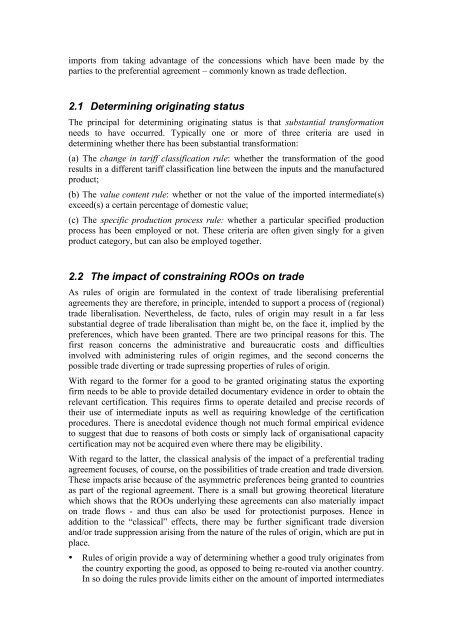PDF, GB, 56 p., 1,3 Mo - Femise
PDF, GB, 56 p., 1,3 Mo - Femise
PDF, GB, 56 p., 1,3 Mo - Femise
Create successful ePaper yourself
Turn your PDF publications into a flip-book with our unique Google optimized e-Paper software.
imports from taking advantage of the concessions which have been made by the<br />
parties to the preferential agreement – commonly known as trade deflection.<br />
2.1 Determining originating status<br />
The principal for determining originating status is that substantial transformation<br />
needs to have occurred. Typically one or more of three criteria are used in<br />
determining whether there has been substantial transformation:<br />
(a) The change in tariff classification rule: whether the transformation of the good<br />
results in a different tariff classification line between the inputs and the manufactured<br />
product;<br />
(b) The value content rule: whether or not the value of the imported intermediate(s)<br />
exceed(s) a certain percentage of domestic value;<br />
(c) The specific production process rule: whether a particular specified production<br />
process has been employed or not. These criteria are often given singly for a given<br />
product category, but can also be employed together.<br />
2.2 The impact of constraining ROOs on trade<br />
As rules of origin are formulated in the context of trade liberalising preferential<br />
agreements they are therefore, in principle, intended to support a process of (regional)<br />
trade liberalisation. Nevertheless, de facto, rules of origin may result in a far less<br />
substantial degree of trade liberalisation than might be, on the face it, implied by the<br />
preferences, which have been granted. There are two principal reasons for this. The<br />
first reason concerns the administrative and bureaucratic costs and difficulties<br />
involved with administering rules of origin regimes, and the second concerns the<br />
possible trade diverting or trade supressing properties of rules of origin.<br />
With regard to the former for a good to be granted originating status the exporting<br />
firm needs to be able to provide detailed documentary evidence in order to obtain the<br />
relevant certification. This requires firms to operate detailed and precise records of<br />
their use of intermediate inputs as well as requiring knowledge of the certification<br />
procedures. There is anecdotal evidence though not much formal empirical evidence<br />
to suggest that due to reasons of both costs or simply lack of organisational capacity<br />
certification may not be acquired even where there may be eligibility.<br />
With regard to the latter, the classical analysis of the impact of a preferential trading<br />
agreement focuses, of course, on the possibilities of trade creation and trade diversion.<br />
These impacts arise because of the asymmetric preferences being granted to countries<br />
as part of the regional agreement. There is a small but growing theoretical literature<br />
which shows that the ROOs underlying these agreements can also materially impact<br />
on trade flows - and thus can also be used for protectionist purposes. Hence in<br />
addition to the “classical” effects, there may be further significant trade diversion<br />
and/or trade suppression arising from the nature of the rules of origin, which are put in<br />
place.<br />
• Rules of origin provide a way of determining whether a good truly originates from<br />
the country exporting the good, as opposed to being re-routed via another country.<br />
In so doing the rules provide limits either on the amount of imported intermediates
















